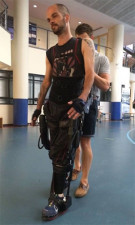
Pretoria-based quadriplegic Jaco Ferreira has seen significant improvement in his spinal cord after participating in a 24-week rehabilitation programme involving walking in a robotic suit.
Fifteen years after a car accident left him partially paralysed, 34-year-old Ferreira, along with 15 other participants, was invited to take part in a research project titled: "The effect of robotic walking and exercise activity-based rehabilitation on muscle activity, health-related benefits, functional capacity and psychological well-being in persons with spinal cord injury," conducted by the Sports Science Institute of SA.
Using a wearable, battery-operated bionic exoskeleton known as Ekso GT, developed by US-based robotic exoskeleton company Ekso Bionics, the research project aims to compare the effects of walking in a robot suit with more conventional rehabilitation exercises to assist those with incomplete spinal cord injuries to live a fuller life.
Sponsored by the Walking with Brandon Foundation, Ekso GT uses smart variable assist software to enable patients with lower extremity weakness or paralysis to stand and walk on level surfaces. Motors power the hip and knee joints, and all motion is initiated either through specific patient actions or the use of an external controller.
"I have been taking part in the study since the end of January and there have already been major improvements to my health. My blood pressure is at a healthier level, the sensation in my pelvic area along with my posture has improved, my pectoral muscles also started waking up and are developing more than they did with pushing my wheelchair for the past 15 years, and there has been more muscle flickers in my legs," notes Ferreira.
The University of Cape Town's division of exercise science and sports medicine says Ferreira has shown signs of significant improvement and could start walking with crutches within the next year if he continues with his dedicated approach to recovery.
"During the study the following is measured: changes in muscle strength and tightness, blood flow, heart rhythm, bone density, daily functions, walking ability and psychological state. Over the period of the project, we have seen Jaco progress in various areas, the most significant of which is his posture. He can now remain upright both in his chair and while walking in the suit with very little strain through his neck and shoulders. Other areas of substantial improvement are his blood pressure control and grip strength."
With the study ending last week, Ferreira has started a crowdfunding campaign with Backabuddy, to raise funds for the equipment he will need to go about the next stage of his life.
"I am hoping to raise approximately R75 000 for an adjustable wheelchair that will accommodate my physical improvements, and crutches and leg braces to continue with the exercise regime when I return home to Pretoria."
Share